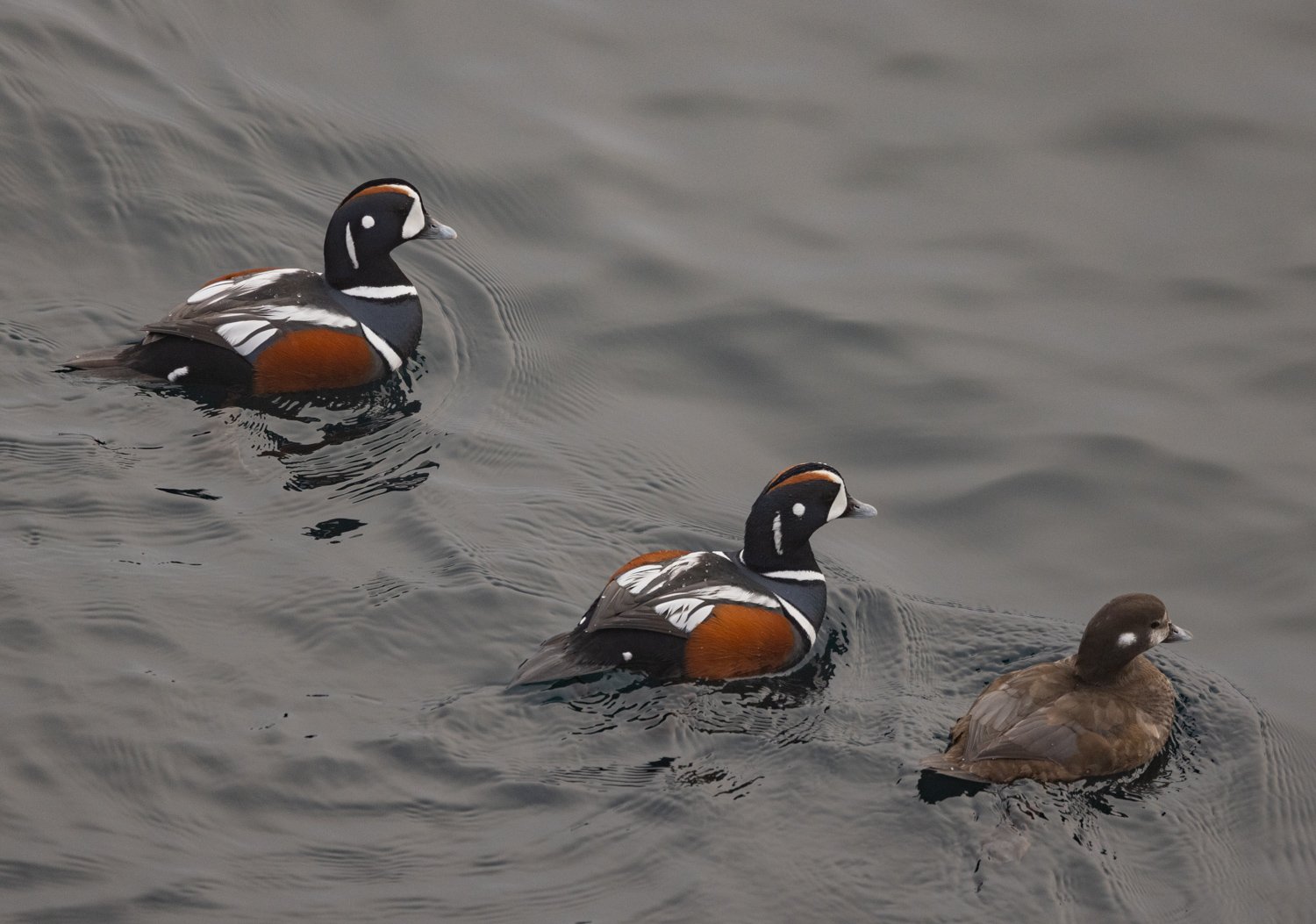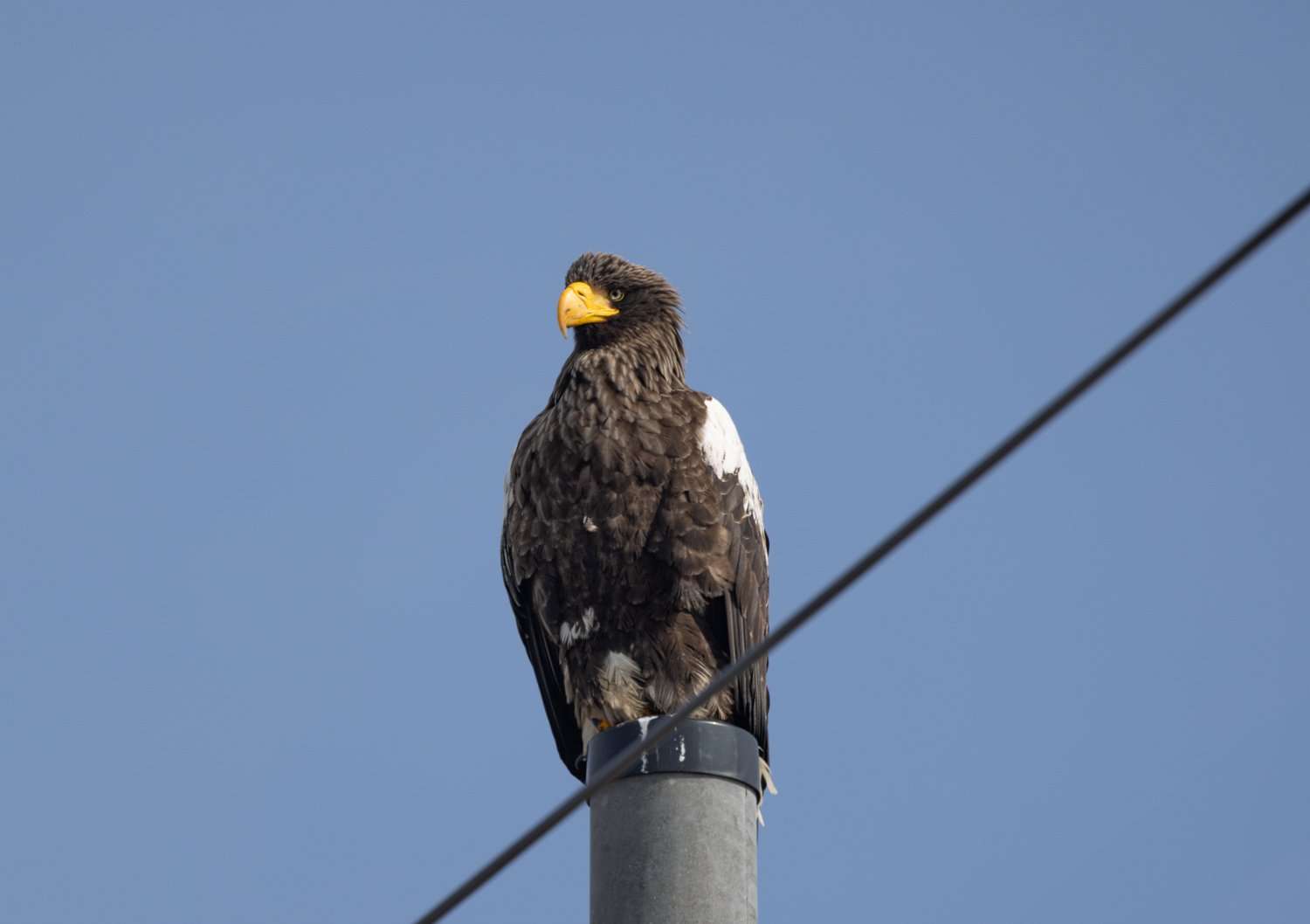Japan has been on my list of places to go for a very long time. What brought Japan to my attention from a wildlife point of view was the chance to see the biggest owl in the world, Blakiston’s Fishing owl, as well as one of the biggest eagles in the world, Steller’s sea eagle.
This trip wasn’t really a wildlife trip, more of a holiday with my girlfriend, but as always with me, seeing new birds or mammals is high on the agenda. I actually started the trip with a bit of snowboarding at Niseko in Hokkaido, on the north island of Japan on the far west side. That came to an abrupt end as I had a bad accident on the slopes and hurt my ankle. I had to be ambulanced off the mountain on a skidoo which was kind of fun but not. So, not a great start, but luckily I had a car to get me around. Anyway I had some great new birds in that area, with Pygmy woodpecker, brown cheeked bulbul, dusky thrush and meadow bunting being the highlights.
We needed to get across the entire island to get to Rausu in the north east, to a place called Shiretoko national park, but the journey was too far so we decided to break it in half and stay in Daisetsuzan national park in a little onsen town (hot springs) called Sounkyo Onsen. It was jaw droppingly beautiful, a real winter wonderland. It was quiet on the wildlife front but a great place to photograph the plentiful deer and landscapes, as well as enjoy some amazing indoor and outdoor thermal hot springs.
The stunning landscapes around Sounkyo Onsen
Other highlights were crested kingfisher and brown dipper. And I got my first Red-crowned cranes of the trip in the farmland on the outskirts of the park, as well as fields full of whooper swans.
Moving on to the main event we proceeded to Shiretoko. It got much colder, and there was still snow on the ground. Most of the interior that I drove through was pretty lifeless, with hardly anything being seen apart from the occasional crow. But as we approached Rausu, things dramatically changed. You could tell you were now in a national park and we were now also by the ocean, the sea of Okhotsk. Gulls were everywhere as it’s a fishing port with lots of harbours with fishing vessels in, and it seemed everyone in this town worked in the fishing industry. Slaty-backed gulls being the most numerous but I also saw black-tailed gull and black-headed gull in good numbers. No doubt there were plenty rarities to be picked out. The bays in the harbour were full of harlequin duck and red-breasted merganser, with both species doing courtship displays. And I don’t think I’ve seen as many foxes in my life, literally everywhere. Then we got cracking views of white-tailed eagle hunting gulls whilst being mobbed by them at the same time.
Evening was setting in and it was time for the main event! There is a family in Rausu who have set up an observation hide for the endangered Blakiston’s fishing owl. From my knowledge this is the only one that exists and the only guaranteed way of seeing this magnificent and rare owl, only 140 are thought to exist in Japan, with a global population of 1400, mainly in Russia. The trouble was that the guys who run the hide don’t speak English and don’t have email, so the only way is by phone. So, before I left the UK, a friend kindly offered to get his Japanese wife to ring them for me to book the hide. An absolute life saver and I couldn’t be more thankful.
Anyway we turned up at the hide and there was nobody there. My heart sank. It was just a house with a large portakabin type hide next to it. We waited and nobody came. I tried the door handle of the hide and it was open, so we just went in and waited there. It didn’t feel right. Nobody came at all, so we just thought we’d hang on and see if the owl would just turn up. We didn’t know whether the owner was supposed to put fish out for it or what, and it all just felt a bit hopeless. Three hours passed and I started to consider what time I’d give up and throw the towel in. My girlfriend wrapped up in lots of layers and fell asleep next to a heater. Then all of a sudden I saw movement at the back of the trees, and a large ghostly figure appeared high up in the darkness. I couldn’t really see it, but I knew it was the owl. I woke my girlfriend up to tell her to get ready as it was about to turn up. 15 minutes passed, as it slowly calculated its next move. Then it swooped down in front of us onto a perch over the river. It was mind blowing!
The hide was strategically placed in front of a floodlit river with a strange pile of pebbles. It took me a while, but I worked out that the owner had engineered the river with pebbles to form an ancient fishing technique to trap live fish. The flow of the river would trap them in, and the owl knows this, and was here ready and waiting to catch them. I have since researched the technique and it looks like its is called Yana. Clever stuff!
Blakiston’s Fish Owl
Blakistons fish-owl fishing
The owl was there for hours, face down looking for movement in the flowing river. We got to observe all its behaviours. Then we were treated to it actually hunting fish. A kill right in front of us. It was great to see. My girlfriend was extremely tired but I didn’t want to open the hide door and flush the owl. But time went on and he was there for hours, so we just had to leave. I kept my eye on him and he really wasn’t bothered by us walking out the hide and remained perched next to the river. What an experience!
The next day, I got up at sunrise which was 5am in this area, and headed out to see the end of the Shiretoko peninsula, which is the far north eastern extreme of Japan. The local Ainu people refer to this as ‘the end of the world’. The fog was really thick and the visibility was terrible but I immediately ran in to this inquisitive fox which seemed to be carrying an injury on its hind leg. So he let me get closer than normal to get these moody shots of him.
I also got better views of Harlequin duck which were close in on one of the harbours and let me get closer due to the fog. One of the nicest looking ducks I’ve ever come across.
Harlequin Duck
Carrion Crow
As I got nearer to the end of the peninsula, the fog magically lifted, and revealed a stunning landscape of snowy forested mountains meeting the icy sea. An amazing scene that felt more like Alaska or Russia.
Shiretoko National Park
A superb drive out, where you even have the chance of seeing Ezo brown bear, a Japanese subspecies of Brown Bear. No luck on the bear front for me though, as I think they weren’t quite out of hibernation just yet. Note, if you do come at a different time of year, then check out some of the nature boat tours they do in this area for chances to see killer whales, bears, Steller’s sea eagle etc. I was really unlucky as all the tour operators were in-between seasons so none were operating while I was there. Maybe a good enough reason to go back.
I went back to the hotel in Rausu for breakfast and to pick up my girlfriend. The fog was still extreme in Rausu, so we decided to drive a bit further out of town to try get beyond it. She is very much into geography and I spotted a huge sand spit on Google Maps that was going out to sea. It was similar to Spurn point in the UK, which is one of the best places we have for birds on migration. So I thought it would be a good place to explore considering it was spring migration in Japan. It turns out it’s the biggest sand spit in Japan, called the Notsuke peninsula, at 27km long, and has a road all the way down it and is now a protected reserve. Winner!
It did not disappoint, and it turned out to be one of the best days birding I’ve ever had, particularly the quality of species. First up was the sheer number of white-tailed eagles. They were more common than pigeons. Every other lamp post had one on, or they were flushing ducks in a nearby pond. Incredible stuff.
White-tailed eagle, Notsuke peninsula
White-tailed Eagle - Notsuke peninsula
Then from afar I noticed a different one, bigger and darker. It was a Steller’s sea eagle, an absolute beauty that let me get really close. I was super super lucky as they are birds that follow the drift ice and mainly occur in Japan in winter. They have mostly left by mid April so there’s every chance these could be the last ones that are heading back to Kamchatca, Russia. I was over the moon, as these birds have been right at the top of my list of things to see for a very long time. Huge dagger like bills, an absolute brute of a thing.
Steller’s Sea-eagle, Notsuke peninsula
Steller’s Sea-eagle, Notsuke peninsula
As we were moving through this bizarre landscape we were constantly seeing different wildlife. Thousands of wigeon, pintail and teal as well as really tame Sika deer and foxes. The water on the inside was steaming with volcanic activity, and looked like a Martian landscape. The dead trees adding to the effect.
I had my closest ever views of black scoter, roadside red-crowned crane, juvenile Steller’s and white tailed eagles, then this shot that really sets the scene. Another adult Steller’s with 3 white tailed eagles, with the Steller’s claiming the post, showing its dominance over these other massive birds.
A fall of Steller’s and White-tailed eagles on Notsuke peninsula
Black Scoter
Red-crowned Crane
Moving on we added smew to the list, then my first ever Stejneger’s scoter in their natural range. Then fleeting views of this beautiful long-tailed rosefinch. Then more and more eagles. I think we finished the spit area with 48 white tailed eagles, 4 Steller’s sea eagle and 5 black kite. Remarkable. Then just to cap of the day nicely we had this huge crested kingfisher fly out to sea in front of us, which led me to spot a group of huge seals in the bay. A wonderful day in Japanese nature.
White-tailed eagle
Stejneger’s scoter
Long-tailed Rosefinch
White-tailed Eagle
Anyway as always, thanks for reading and please subscribe to my newsletter below and follow my travels on instagram @trekadventures. Feedback is always welcome and I really appreciate all the messages and questions I get.

































































